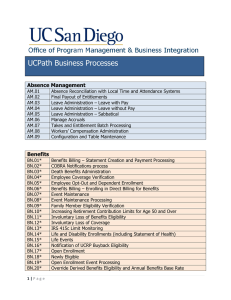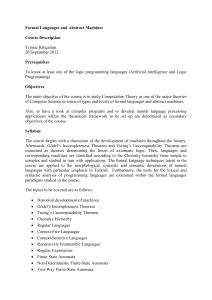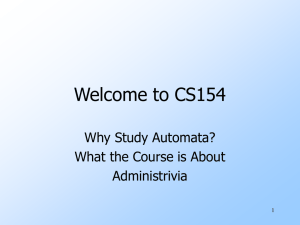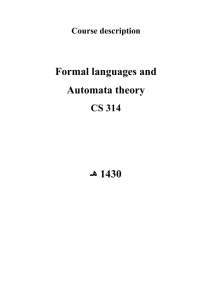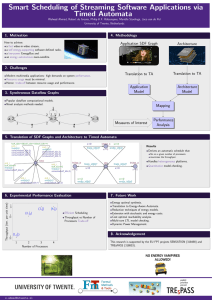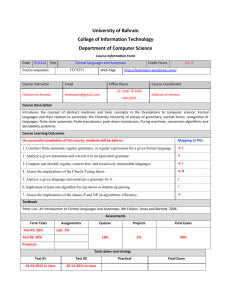Part 8 (Word)
advertisement
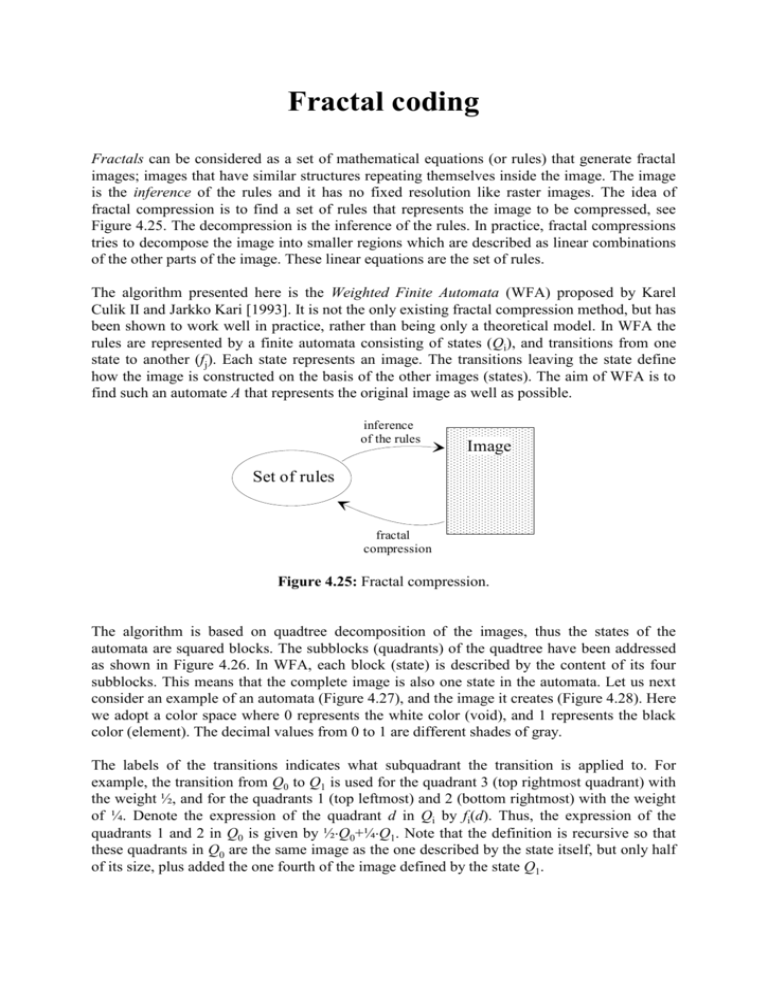
Fractal coding Fractals can be considered as a set of mathematical equations (or rules) that generate fractal images; images that have similar structures repeating themselves inside the image. The image is the inference of the rules and it has no fixed resolution like raster images. The idea of fractal compression is to find a set of rules that represents the image to be compressed, see Figure 4.25. The decompression is the inference of the rules. In practice, fractal compressions tries to decompose the image into smaller regions which are described as linear combinations of the other parts of the image. These linear equations are the set of rules. The algorithm presented here is the Weighted Finite Automata (WFA) proposed by Karel Culik II and Jarkko Kari [1993]. It is not the only existing fractal compression method, but has been shown to work well in practice, rather than being only a theoretical model. In WFA the rules are represented by a finite automata consisting of states (Qi), and transitions from one state to another (fj). Each state represents an image. The transitions leaving the state define how the image is constructed on the basis of the other images (states). The aim of WFA is to find such an automate A that represents the original image as well as possible. inference of the rules Image Set of rules fractal compression Figure 4.25: Fractal compression. The algorithm is based on quadtree decomposition of the images, thus the states of the automata are squared blocks. The subblocks (quadrants) of the quadtree have been addressed as shown in Figure 4.26. In WFA, each block (state) is described by the content of its four subblocks. This means that the complete image is also one state in the automata. Let us next consider an example of an automata (Figure 4.27), and the image it creates (Figure 4.28). Here we adopt a color space where 0 represents the white color (void), and 1 represents the black color (element). The decimal values from 0 to 1 are different shades of gray. The labels of the transitions indicates what subquadrant the transition is applied to. For example, the transition from Q0 to Q1 is used for the quadrant 3 (top rightmost quadrant) with the weight ½, and for the quadrants 1 (top leftmost) and 2 (bottom rightmost) with the weight of ¼. Denote the expression of the quadrant d in Qi by fi(d). Thus, the expression of the quadrants 1 and 2 in Q0 is given by ½Q0+¼Q1. Note that the definition is recursive so that these quadrants in Q0 are the same image as the one described by the state itself, but only half of its size, plus added the one fourth of the image defined by the state Q1. A 2k2k resolution representation of the image in Q0 is constructed by assigning the pixels by a value f0(s), where s is the k-length string of the pixel's address in the kth level of the quadtree. For an example, the pixel values at the addresses 00, 03, 30, and 33 are given below: f0 00 1 1 1 1 1 1 1 f0 0 f0 () 2 2 2 2 2 2 8 f0 03 1 1 1 1 3 f0 3 1 2 f0 () 1 2 f1 () 2 2 8 4 8 (4.15) f0 30 1 1 1 1 1 1 1 5 f0 0 f1 0 f0 () f1 () 2 2 2 2 2 8 2 8 (4.16) f0 33 1 1 1 1 1 1 1 7 f0 3 f1 3 1 2 f0 () 1 2 f1 () f1 () 2 2 2 2 8 4 2 8 (4.14) (4.17) Note, that fi() with empty string evaluates to the final weight of the state, which is ½ in Q0 and 1 in Q1. The image at three different resolutions is shown in Figure 4.28. 1 3 0 2 (a) 11 13 31 33 10 12 30 32 01 03 21 23 00 02 20 22 (b) (c) Figure 4.26: (a) The principle of addressing the quadrants; (b) Example of addressing at the resolution of 44; (c) The subsquare specified by the string 320. 0,1,2,3 ( 1/2) 0,1,2,3 (1) 1,2 ( 1/4 ) 1/ 2 1 Q0 Q1 3 ( 1/2 ) Figure 4.27: A diagram for a WFA defining the linear grayness function of Figure 4.28. 4 6 2 4 /8 /8 4/ 8 3/ 8 2 /8 1 /8 /8 /8 2x2 5/ 8 4/ 8 3 /8 2 /8 6/ 8 5/ 8 4 /8 3 /8 7/ 8 6/ 8 5 /8 4 /8 4x4 128 x 128 Figure 4.28: Image generated by the automata in Figure 4.27 at different resolutions. The second example is the automata given in Figure 4.29. Here the states are illustrated by the images they define. The state Q1 is expressed in the following way. The quadrant 0 is the same as Q0, whereas the quadrant 3 is empty so no transitions with the label 3 exists. The quadrants 1 and 2, on the other hand, are recursively described by the same state Q1. The state Q2 is expressed as follows. The quadrant 0 is the same as Q1, and the quadrant 3 is empty. The quadrants 1 and 2 are again recursively described by the same state Q2. Besides the different color (shading gray) the left part of the diagram (states Q3, Q4, Q5) is the same as the right part (states Q0, Q1, Q2). For example, Q4 has the shape of Q1 but the color of Q3. The state Q5 is described so that the quadrant 0 is Q4, quadrant 1 is Q2, and quadrant 2 is the same as the state itself. 2 (1) Q5 1,2 (1) Q2 1 (1) 0 (1) 1,2 ( 1/2) 0 (1) Q4 1,2 (1) Q1 1 ( 1/2) 0 (1) 0,1,2,3 ( 1/2) 0 (1) 0,1,2,3 (1) Q3 Q0 1,3 ( 1/4 ) Figure 4.29: A WFA generating the diminishing triangles. WFA algorithm: The aim of WFA is to find such an automata that describes the original image as closely as possible, and is as small as possible by its size. The distortion is measured by TSE (total square error). The size of the automata can be approximated by the number of states and transitions. The minimized optimization criteria is thus: d k f , f A G size A (4.18) The G-parameter defines how much emphasis is put on the distortion and to the bit rate. It is left as an adjusting parameter for the user. The higher is the G, the smaller bit rates will be achieved at the cost of image quality, and vice versa. Typically G has values from 0.003 to 0.2. The WFA-algorithm compresses the blocks of the quadtree in two different ways: by a linear combination of the functions of existing states by adding new state to the automata, and recursively compressing its four subquadrants. Whichever alternative yields a better result in minimizing (4.18) is then chosen. A small set of states (initial basis) is predefined. The functions in the basis do not need even to be defined by a WFA. The choice of the functions can, of course, depend on the type of images one wants to compress. The initial basis in [Culik & Kari, 1993] resembles the codebook in vector quantization, which can be viewed as a very restricted version of the WFA fractal compression algorithm. The algorithm starts at the top level of the quadtree, which is the complete image. It is then compressed by the WFA algorithm, see Figure 4.30. The linear combination of a certain block is chosen by the following greedy heuristic: The subquadrant k of a block i is matched against each existing state in the automata. The best match j is chosen, and a transition from i to j is created with the label k. The match is made between normalized blocks so that their size and average value are scaled to be equal. The weight of the transition is the relative difference between the mean values. The process is then repeated for the residual, and is carried over until the reduction in the square error between the original and the block described by the linear combination is low enough. It is a trade-off between the increase in the bit rate and the decrease in the distortion. Initial basis: Initial basis: Q1 Q2 Q3 w1 Q4 w2 Q5 Q6 Q1 Q2 Q3 Q4 Q5 Q6 w3 Image (a) Image 1 Q0 (b) Figure 4.30: Two ways of describing the image: (a) by the linear combination of existing states; (b) by creating a new state which is recursively processed. WFA algorithm for wavelet transformed image: A modification of the algorithm that yields good results is to combine the WFA with a wavelet transformation [DeVore et al. 1992]. Instead of applying the algorithm directly to the original image, one first makes a wavelet transformation on the image and writes the wavelet coefficients in the Mallat form. Because the wavelet transform has not been considered earlier, the details of this modification are omitted here. Compressing the automata: The final bitstream of the compressed automata consists of three parts: Quadree structure of the image decomposition. Transitions of the automata Weights of the transitions A bit in the quadtree structure indicates whether a certain block is described as a linear combination of the other blocks (a set of transitions), or by a new state in the automata. Thus the states of the automata are implicitly included in the quadtree. The initial states need not to be stored. The transitions are stored in an nn matrix, where each non-zero cell M(i, j)=wij describes that there is a transition from Qi to Qj having the weight wij. If there is no transition between i and j, wij is set to zero. The label (0,1,2, or 3) is not stored. Instead there are four different matrices, one for each subquadrant label. The matrices Mk(i, j) (k=0,1,2,3) are then represented as binary matrices Bk(i, j) so that B(i, j)=1 if and only if wij0; otherwise B(i, j)=0. The consequence of this is that only the non-zero weights are needed to store. The binary matrices are very sparse because for each state only few transitions exists, therefore they can be efficiently coded by run-length coding. Some states are more frequently used in linear combinations than other, thus arithmetic coding using the column j as the context was considered in [Kari & Fränti, 1994]. The non-zero weights are then quantized and a variable length coding (similar to the FELICS coding) is applied. The results of the WFA outperform that of the JPEG, especially at the very low bit rates. Figures 4.31 and 4.32 illustrate test image Lena when compressed by WFA at the bit rates 0.30, 0.20, and 0.10. The automata (at the 0.20 bpp) consists of 477 states and 4843 transitions. The quadtree requires 1088 bits, whereas the bitmatrices 25850, and the weights 25072 bits. Original bpp = 8.00 WFA mse = 0.00 bpp = 0.30 WFA bpp = 0.20 mse = 49.32 WFA mse = 70.96 bpp = 0.10 Figure 4.31: Test image Lena compressed by WFA. mse = 130.03 Original bpp = 8.00 WFA mse = 0.00 bpp = 0.30 mse = 70.96 bpp = 0.10 WFA bpp = 0.20 mse = 49.32 WFA mse = 130.03 Figure 4.32: Magnifications of Lena compressed by WFA. Video images Video images can be regarded as a three-dimensional generalization of still images, where the third dimension is time. Each frame of a video sequence can be compressed by any image compression algorithm. A method where the images are separately coded by JPEG is sometimes referred as Motion JPEG (M-JPEG). A more sophisticated approach is to take advantage of the temporal correlations; i.e. the fact that subsequent images resemble each other very much. This is the case in the latest video compression standard MPEG (Moving Pictures Expert Group). MPEG MPEG standard consists of both video and audio compression. MPEG standard includes also many technical specifications such as image resolution, video and audio synchronization, multiplexing of the data packets, network protocol, and so on. Here we consider only the video compression in the algorithmic level. The MPEG algorithm relies on two basic techniques Block based motion compensation DCT based compression MPEG itself does not specify the encoder at all, but only the structure of the decoder, and what kind of bit stream the encoder should produce. Temporal prediction techniques with motion compensation are used to exploit the strong temporal correlation of video signals. The motion is estimated by predicting the current frame on the basis of certain previous and/or forward frame. The information sent to the decoder consists of the compressed DCT coefficients of the residual block together with the motion vector. There are three types of pictures in MPEG: Intra-pictures (I) Predicted pictures (P) Bidirectionally predicted pictures (B) Figure 5.1 demonstrates the position of the different types of pictures. Every Nth frame in the video sequence is an I-picture, and every Mth frame a P-picture. Here N=12 and M=4. The rest of the frames are B-pictures. Compression of the picture types: Intra pictures are coded as still images by DCT algorithm similarly than in JPEG. They provide access points for random access, but only with moderate compression. Predicted pictures are coded with reference to a past picture. The current frame is predicted on the basis of the previous I- or P-picture. The residual (difference between the prediction and the original picture) is then compressed by DCT. Bidirectional pictures are similarly coded than the P-pictures, but the prediction can be made both to a past and a future frame which can be I- or P-pictures. Bidirectional pictures are never used as reference. The pictures are divided into 1616 macroblocks, each consisting of four 88 elementary blocks. The B-pictures are not always coded by bidirectional prediction, but four different prediction techniques can be used: Bidirectional prediction Forward prediction Backward prediction Intra coding. The choice of the prediction method is chosen for each macroblock separately. The bidirectional prediction is used whenever possible. However, in the case of sudden camera movements, or a breaking point of the video sequence, the best predictor can sometimes be given by the forward predictor (if the current frame is before the breaking point), or backward prediction (if the current frame is after the breaking point). The one that gives the best match is chosen. If none of the predictors is good enough, the macroblock is coded by intra-coding. Thus, the B-pictures can consist of macroblock coded like the I-, and P-pictures. The intra-coded blocks are quantized differently from the predicted blocks. This is because intra-coded blocks contain information in all frequencies and are very likely to produce 'blocking effect' if quantized too coarsely. The predicted blocks, on the other hand, contain mostly high frequencies and can be quantized with more coarse quantization tables. Forward prediction Forward prediction I B B B P B B B P B B B I Bidirectional prediction Figure 5.1: Interframe coding in MPEG. Motion estimation: The prediction block in the reference frame is not necessarily in the same coordinates than the block in the current frame. Because of motion in the image sequence, the most suitable predictor for the current block may exist anywhere in the reference frame. The motion estimation specifies where the best prediction (best match) is found, whereas motion compensation merely consists of calculating the difference between the reference and the current block. The motion information consists of one vector for forward predicted and backward predicted macroblocks, and of two vectors for bidirectionally predicted macroblocks. The MPEG standard does not specify how the motion vectors are to be computed, however, block matching techniques are widely used. The idea is to find in the reference frame a similar macroblock to the macroblock in the current frame (within a predefined search range). The candidate blocks in the reference frame are compared to the current one. The one minimizing a cost function measuring the mismatch between the blocks, is the one which is chosen as reference block. Exhaustive search where all the possible motion vectors are considered are known to give good results. Because the full searches with a large search range have such a high computational cost, alternatives such as telescopic and hierarchical searches have been investigated. In the former one, the result of motion estimation at a previous time is used as a starting point for refinement at the current time, thus allowing relatively narrow searches even for large motion vectors. In hierarchical searches, a lower resolution representation of the image sequence is formed by filtering and subsampling. At a reduced resolution the computational complexity is greatly reduced, and the result of the lower resolution search can be used as a starting point for reduced search range conclusion at full resolution. Motion compensation and DCT examples: http://rnvs.informatik.tu-chemnitz.de/~jan/MPEG/HTML/mpeg_tech.html MPEG: http://www.cs.sfu.ca/undergrad/CourseMaterials/CMPT365/material/notes/Chap4/Chap4.2/Chap4.2.html#MPEG MPEG home page: http://mpeg.telecomitalialab.com/ Motion estimation algorithms: http://www.ece.umd.edu/class/enee631/lecture/631F01_lec13.pdf Min Wu’s Course page: http://www.ece.umd.edu/class/enee631/ http://www.ece.umd.edu/class/enee631/lecture/631F01_lec12.pdf


